Nuclear breakout time represents one of the most critical metrics in global security discussions, yet it remains poorly understood outside specialist circles 12. The concept serves as a fundamental yardstick for assessing proliferation risks and the effectiveness of nuclear nonproliferation efforts worldwide 3.
At its core, breakout time refers to the estimated period required for a nation to produce enough weapons-grade uranium for a single nuclear weapon 24. This timeline begins from the moment a country might make a political decision to pursue nuclear weapons 15.
For policymakers and security experts, this metric provides a crucial window of opportunity for diplomatic interventions, economic sanctions, or potentially more drastic measures to prevent nuclear proliferation 36.

Satellite map illustrating presumed nuclear or significant strategic sites within Iran and Israel.
Understanding the Technical Foundations
Breakout time calculations focus primarily on the uranium enrichment process, the most technically challenging aspect of developing a nuclear weapon 78. Natural uranium contains just 0.7% of the fissile isotope U-235, which must be concentrated to much higher levels for weapons use 94.
The international community typically defines weapons-grade uranium as containing at least 90% U-235 concentration 108. However, material enriched to 60% already represents a significant proliferation concern, as the final enrichment steps proceed much faster than initial ones 411.
Enrichment occurs in specialized facilities using gas centrifuges arranged in cascades, where uranium hexafluoride gas (UF6) is spun at extremely high speeds to separate the lighter U-235 isotopes from the heavier U-238 810.
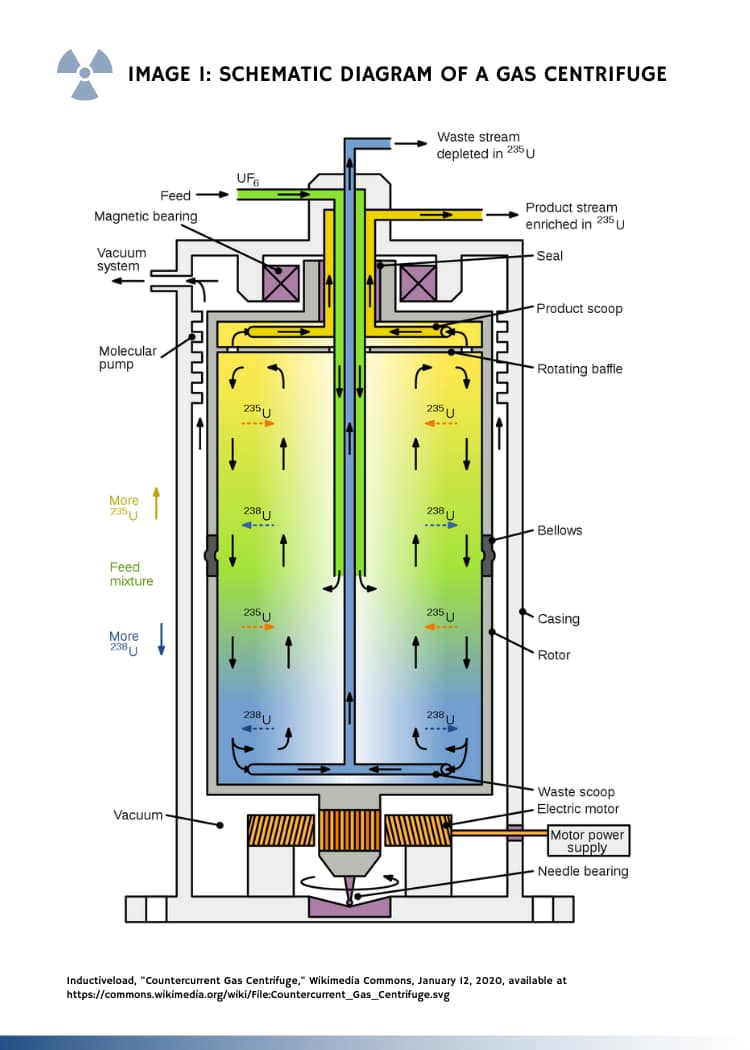
Schematic diagram illustrating the operation of a gas centrifuge, a key technology for uranium enrichment by separating uranium-235 from uranium-238 isotopes.
The effectiveness of this process is measured in Separative Work Units (SWU), which quantify the effort required to separate uranium isotopes 712. Higher SWU capacity translates directly to faster potential enrichment and shorter breakout times 713.
A single IR-1 centrifuge, the first-generation model used extensively in Iran, typically produces between 0.75 and 1 SWU per year 37. Advanced centrifuges, like Iran’s IR-6 models, can achieve 5-10 SWU per year or more 1114.
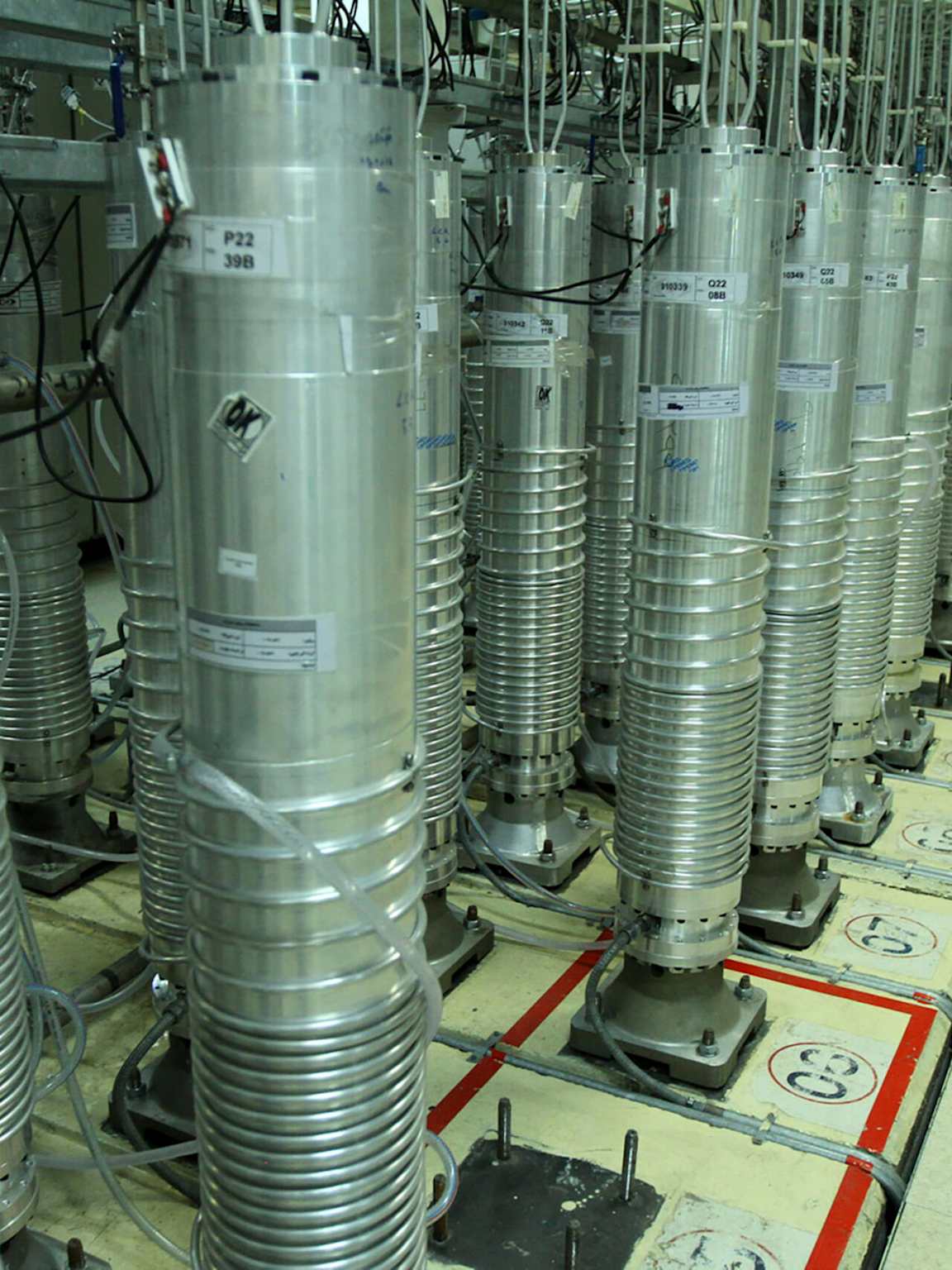
A cascade of uranium enrichment centrifuges operating inside a nuclear facility.
The Mathematics Behind Breakout Calculation
Calculating breakout time involves complex formulas that account for multiple variables 1516. These include the number and type of operational centrifuges, their performance efficiency, the quantity and enrichment level of existing uranium stockpiles, and the target amount of weapons-grade material 133.
The standard unit of measurement is the “significant quantity” (SQ), defined by the International Atomic Energy Agency (IAEA) as approximately 27 kilograms of uranium enriched above 90% 317. This represents the theoretical minimum amount needed for a single nuclear device 35.
The key insight in breakout calculations is that starting from higher enrichment levels dramatically reduces the work required 813. The effort needed to reach weapons-grade material decreases exponentially as the starting enrichment level increases 1517.
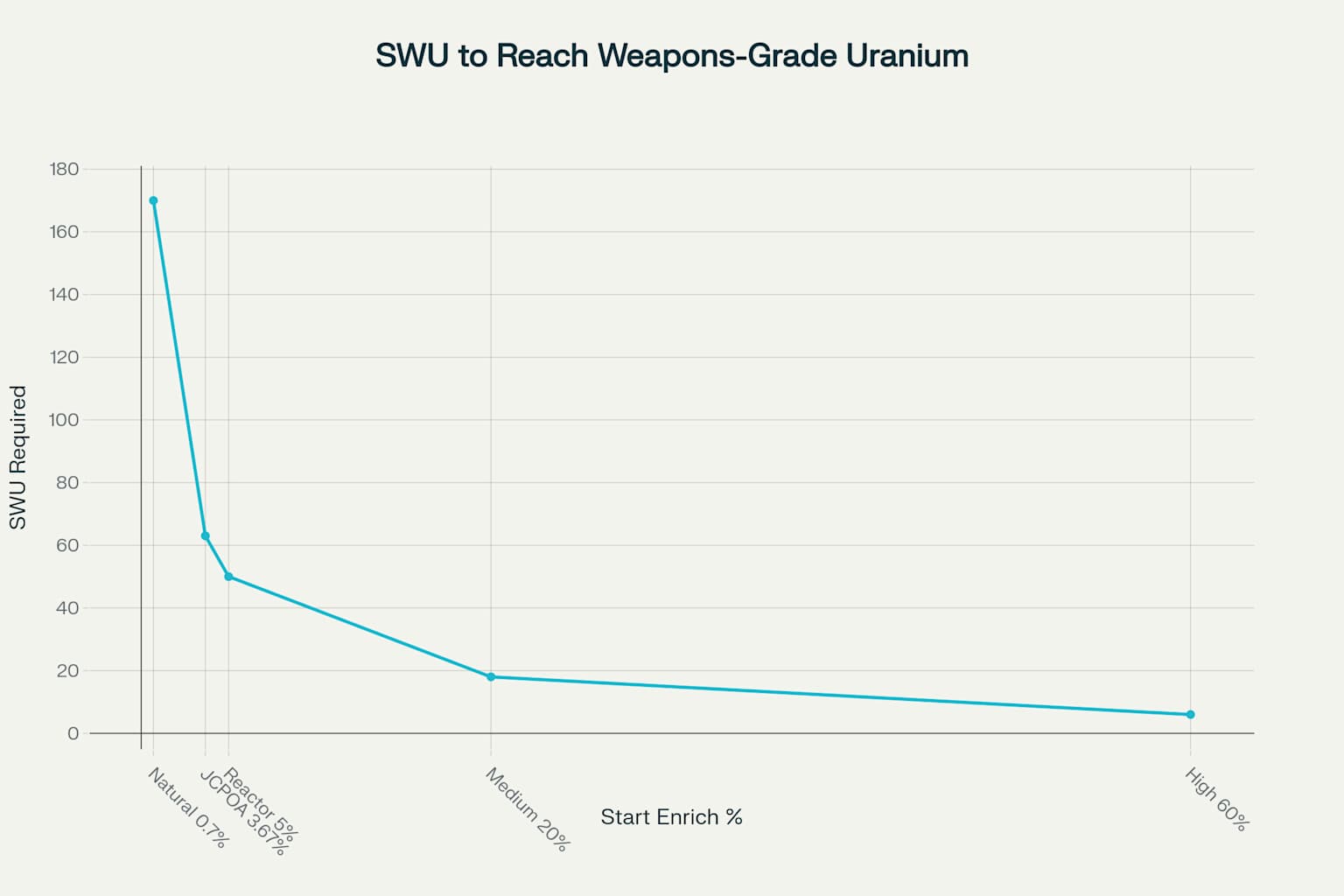
SWU Required to Reach Weapons-Grade Uranium from Different Starting Points
For example, enriching from natural uranium (0.7%) to 90% requires approximately 170 SWU per kilogram 37. However, starting from 20% enriched uranium requires only about 17-18 SWU per kilogram to reach weapons-grade 38.
This explains why international agreements, like the 2015 Joint Comprehensive Plan of Action (JCPOA), placed strict limits on both enrichment levels and stockpile sizes 616. Under the JCPOA, Iran was limited to 3.67% enrichment and a 300kg stockpile, extending its breakout time to approximately 12 months 63.
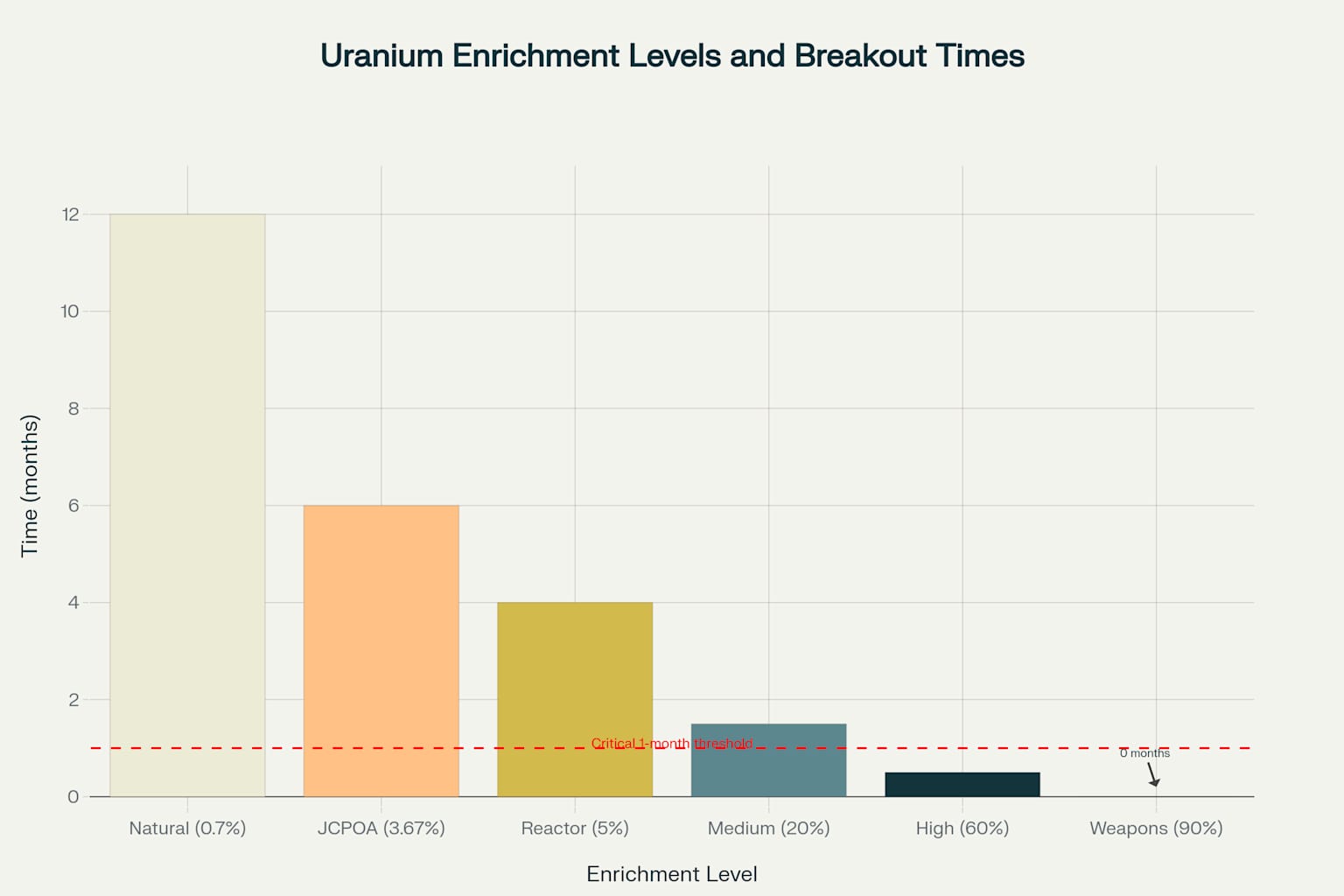
Uranium Enrichment Levels and Approximate Breakout Times
Iran’s Nuclear Infrastructure
Iran possesses two major uranium enrichment facilities that form the backbone of its nuclear program: Natanz and Fordow 1819. These facilities house thousands of centrifuges used for uranium enrichment 2021.
The Natanz facility, located in central Iran, is Iran’s primary enrichment site 2122. It consists of both above-ground facilities and underground enrichment halls designed to withstand potential military strikes 2118.
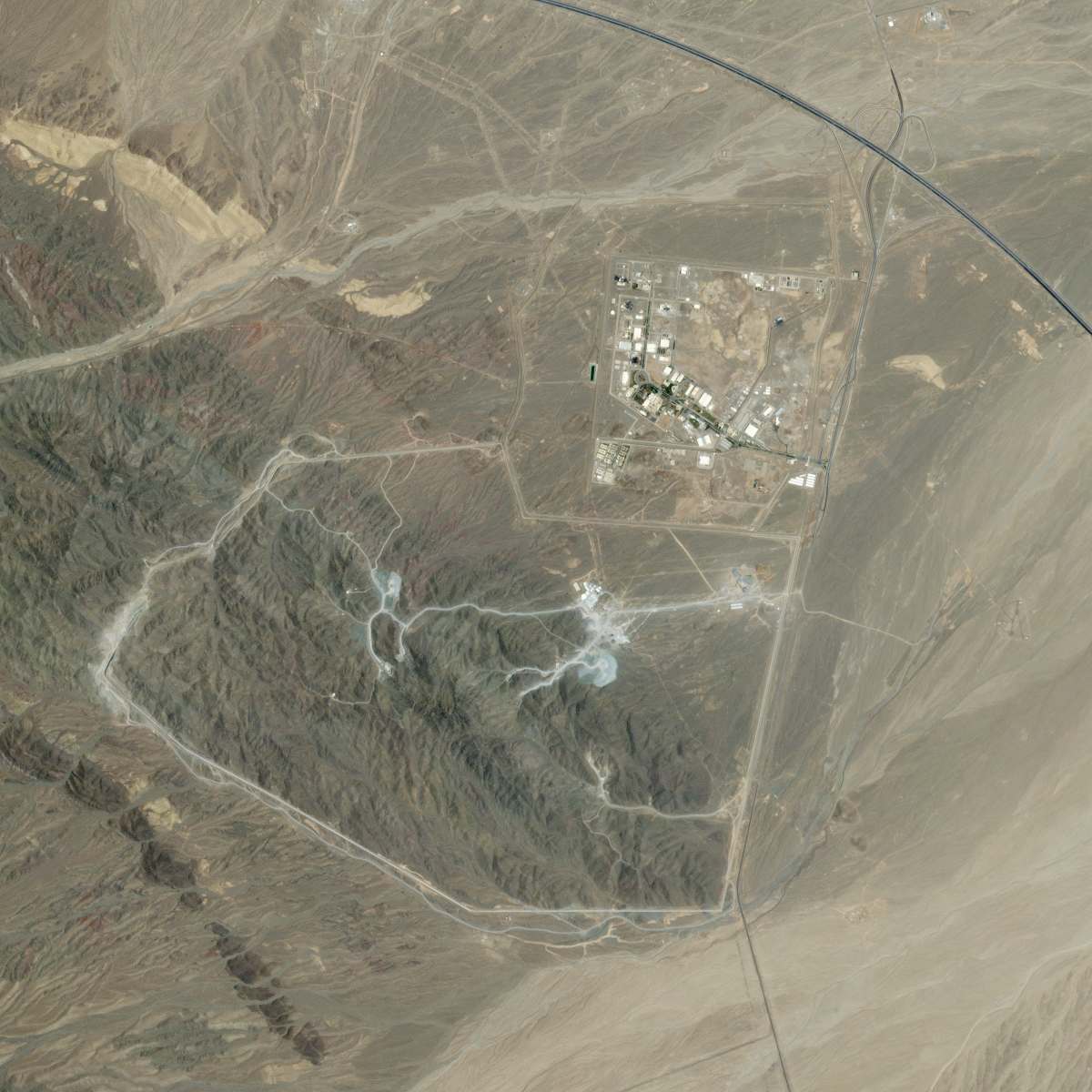
Aerial view of the Natanz nuclear facility in Iran, a key site for uranium enrichment.
Fordow, the second major enrichment facility, is built deep inside a mountain near the city of Qom 1920. Its underground location provides significant protection against potential airstrikes, making it particularly concerning to international observers 2318.
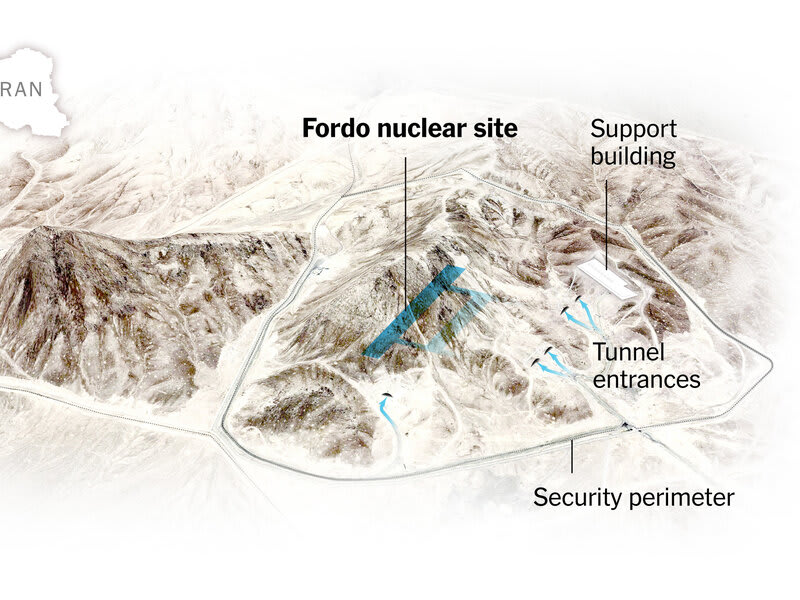
An illustrative aerial map detailing the underground Fordow nuclear site in Iran, showing tunnel entrances, support buildings, and the security perimeter.
Recent reports indicate that Iran has significantly expanded its enrichment capacity at both facilities 1924. The IAEA has reported that Iran installed numerous new centrifuges at Natanz and Fordow in 2024 and 2025, more than tripling Fordow’s capacity to produce uranium enriched to 60% 1925.

Map illustrating the locations and types of Iran’s nuclear facilities, including enrichment plants, research reactors, and uranium mines across the country.
The Evolution of Iran’s Breakout Time
Iran’s nuclear breakout timeline has fluctuated significantly over the past decade, largely in response to diplomatic developments and international agreements 624. Under the 2015 JCPOA, Iran’s breakout time was extended to approximately 12 months through restrictions on enrichment levels, centrifuge numbers, and stockpile sizes 36.
However, following the U.S. withdrawal from the agreement in 2018, Iran gradually began exceeding JCPOA limitations 626. By 2020, Iran had reduced its compliance with key provisions, shortening its breakout time to approximately six months 2617.
The situation continued to deteriorate in subsequent years 2627. By 2022, Iran had begun enriching uranium to 60% at both Natanz and Fordow facilities, reaching a level just one technical step away from weapons-grade material 2414.
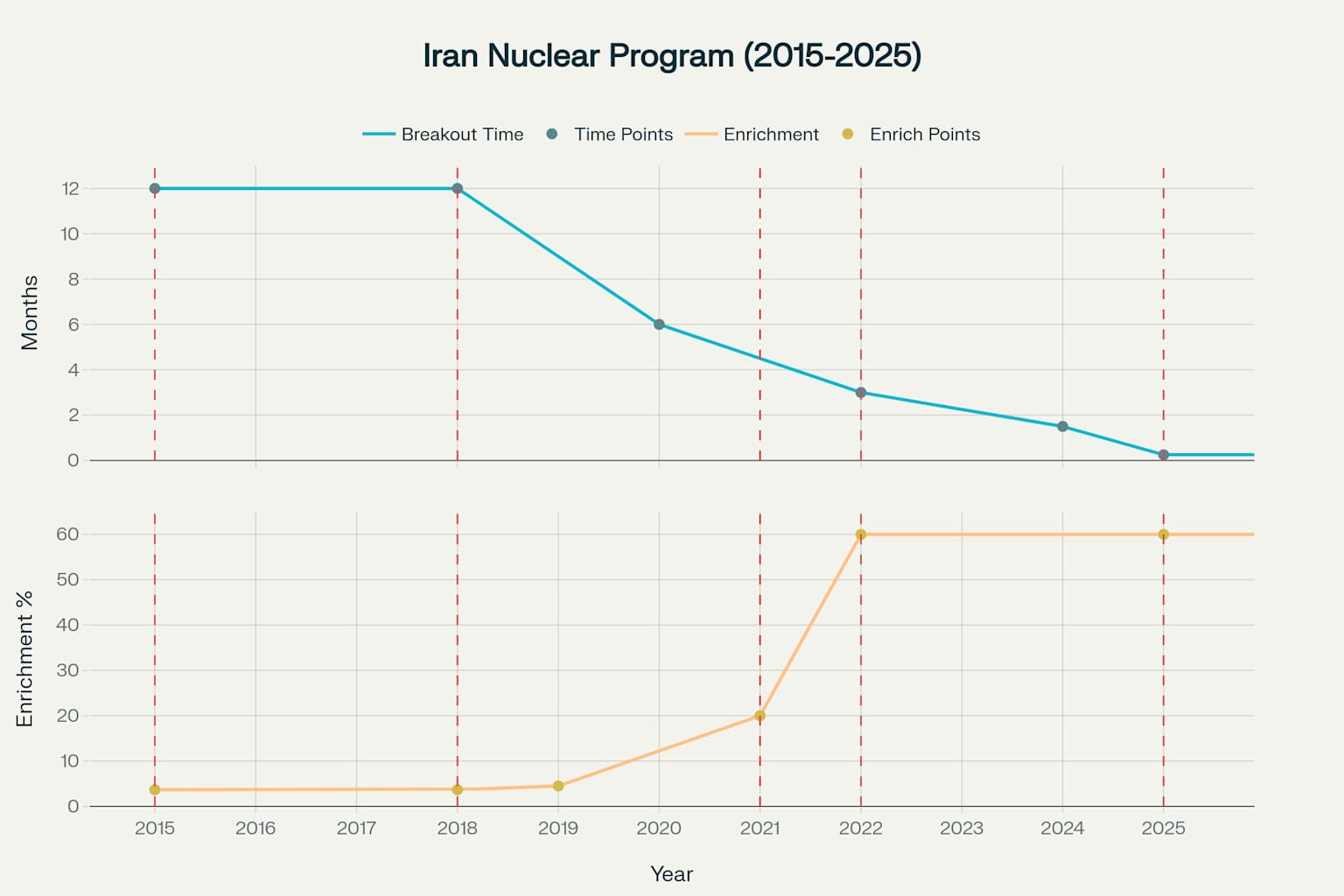
Iran’s Nuclear Breakout Time and Enrichment Levels (2015-2025)
As of mid-2025, according to the latest IAEA reports and expert assessments, Iran’s stockpile of highly enriched uranium has continued to grow significantly 2724. Recent IAEA data indicates Iran possesses over 100 kilograms of uranium enriched to 60% purity, alongside larger quantities at lower enrichment levels 2427.
This stockpile, combined with Iran’s expanded centrifuge capacity, has dramatically reduced its breakout time 2824. Current U.S. government assessments place Iran’s breakout time at approximately 1-2 weeks 528.
Verification Challenges and Uncertainties
Accurately calculating breakout time presents significant challenges for international monitors and intelligence agencies 2930. The IAEA’s ability to verify Iran’s nuclear activities has been severely limited in recent years, creating information gaps that complicate breakout assessments 2730.
The IAEA has reported that its “verification and monitoring has been seriously affected” by Iran’s decision to cease implementation of various monitoring protocols 2731. This has resulted in lost “continuity of knowledge” regarding centrifuge production, uranium stockpiles, and other critical variables 2730.

Gas centrifuges arranged in a cascade within a uranium enrichment facility.
Technical uncertainties also affect breakout calculations 1617. Assumptions about centrifuge performance, cascade configurations, and operational efficiency can significantly impact the estimated timeline 1716. These factors must be modeled based on available information and reasonable assumptions 168.
Another complicating factor is the distinction between “breakout” and “sneak-out” scenarios 174. While breakout calculations typically assume the use of declared facilities under international monitoring, a “sneak-out” involves clandestine facilities and activities that would be much harder to detect 417.

Rows of gas centrifuges inside a uranium enrichment facility, demonstrating the scale of equipment used for nuclear material production.
Beyond Enrichment: The Final Steps
It’s important to note that breakout time calculations typically focus only on the time required to produce weapons-grade uranium 35. They do not account for the additional steps needed to convert that material into an actual nuclear weapon 517.
After achieving sufficient weapons-grade uranium, a country would still need to convert the uranium hexafluoride gas into uranium metal, fabricate weapon components, assemble the device, and potentially conduct tests 35. These additional steps could require several months to complete 285.
However, much of this weaponization work could potentially proceed in parallel with uranium enrichment 1711. Some experts believe Iran may have already conducted research on weapon design and related technologies, though Iran has consistently denied any military dimensions to its nuclear program 3226.
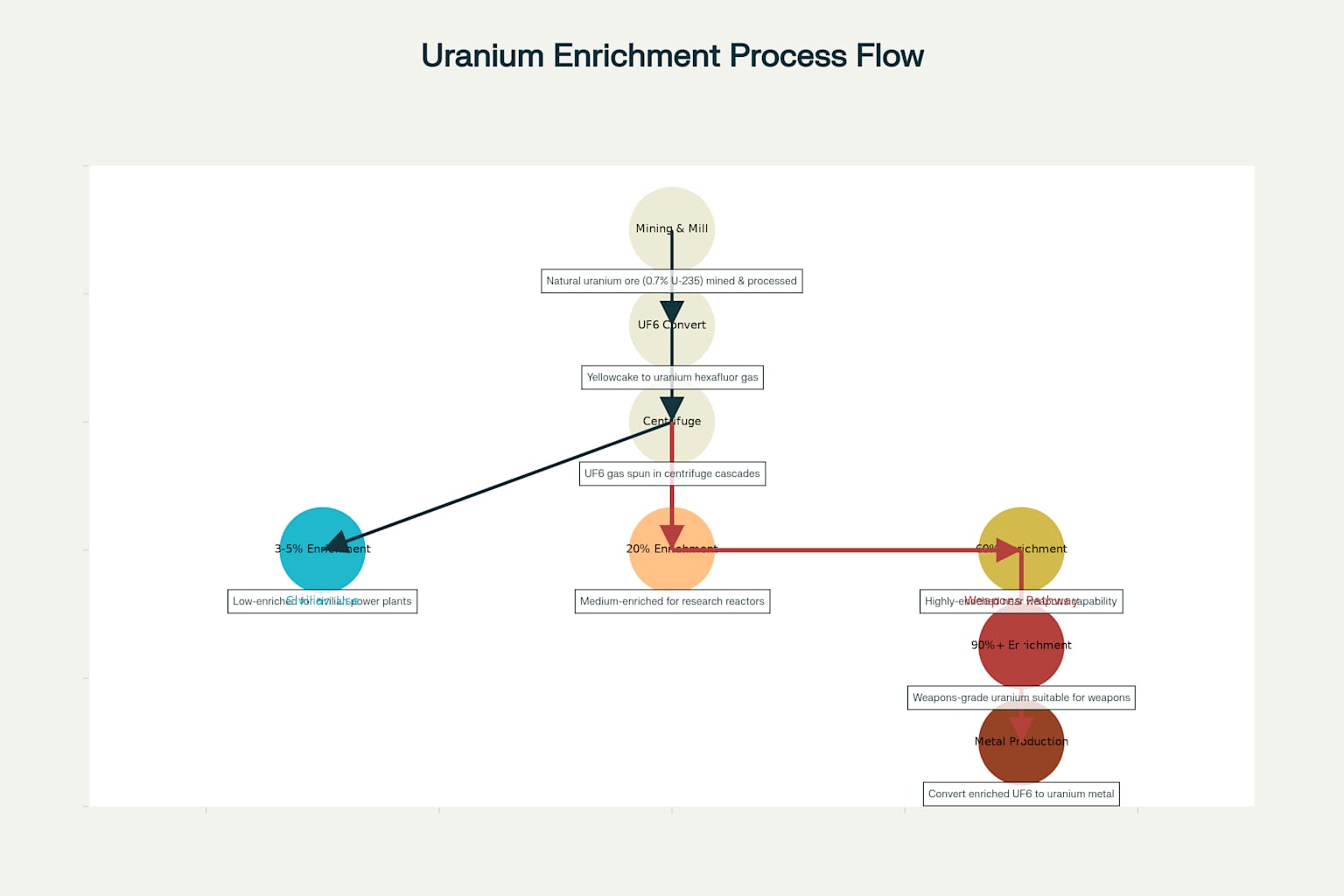
Uranium Enrichment Process: From Mining to Weapons-Grade Material
The IAEA has previously investigated what it termed “possible military dimensions” (PMD) of Iran’s nuclear program 326. These investigations uncovered evidence suggesting Iran had conducted research relevant to nuclear weapons development prior to 2003, with some activities potentially continuing afterward 3211.
Current Assessment and International Response
As of mid-2025, Iran’s nuclear program represents a significant proliferation concern 2428. The combination of high enrichment levels, substantial stockpiles, and reduced monitoring has created a precarious situation 2728.
U.S. Secretary of State Marco Rubio recently stated, “Once you’re at 60%, you’re 90% of the way there. You are, in essence, a threshold nuclear weapons state, which is what Iran basically has become” 2811.
The international community continues to seek diplomatic solutions while maintaining pressure through sanctions and other measures 2628. The IAEA Board of Governors has repeatedly called for Iran to provide necessary cooperation with verification efforts 3332.
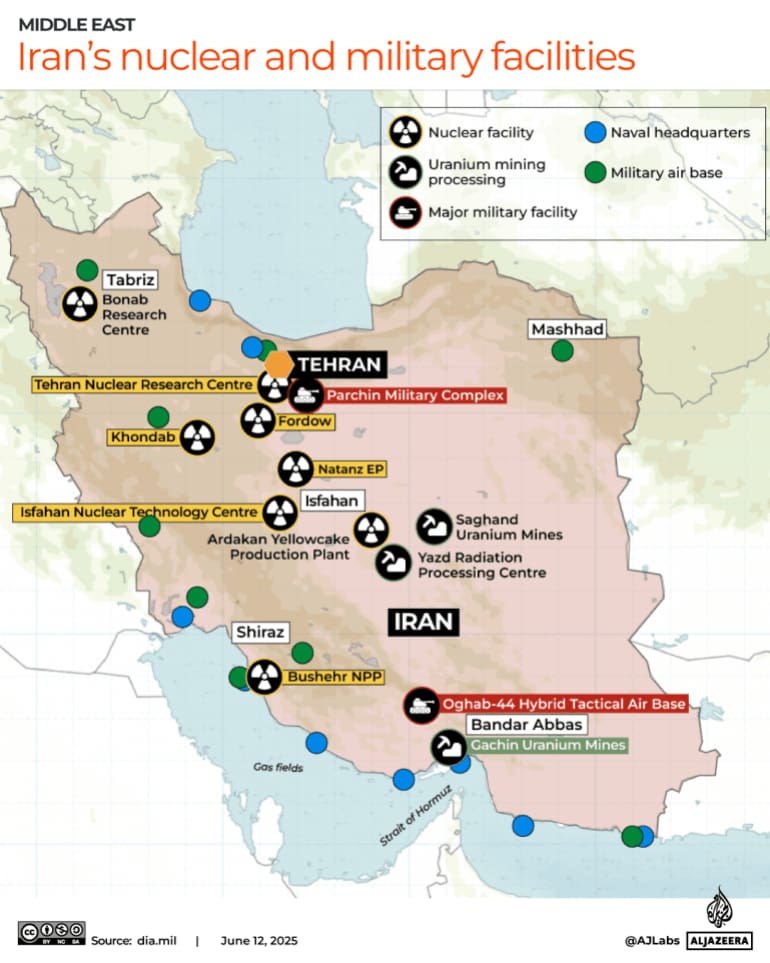
Map showing the locations of Iran’s key nuclear and military facilities.
Recent military tensions between Iran and Israel have further complicated the situation 1819. Israel has conducted strikes against various Iranian facilities, including targeting the above-ground portion of the Natanz enrichment plant 2921. However, the underground Fordow facility has reportedly remained undamaged 2914.
The United States and European powers have discussed potentially triggering the “snapback” mechanism under UN Security Council Resolution 2231, which would reimpose UN sanctions on Iran 266. This mechanism expires in October 2025, creating a sense of urgency in diplomatic efforts 2624.
Implications for Global Security
The concept of breakout time has profound implications for international security and nuclear nonproliferation efforts 13. Short breakout times increase the risk that a country could achieve nuclear weapons capability before the international community can effectively respond 35.
This creates pressure for preemptive action, whether diplomatic, economic, or military 518. It also complicates verification efforts, as continuous monitoring becomes more critical when potential breakout scenarios compress to weeks or days 2731.
The evolution of Iran’s nuclear program and the ongoing challenges in monitoring and verification highlight the inherent limitations of technical safeguards alone 3231. Political commitments, diplomatic engagement, and comprehensive agreements remain essential components of effective nonproliferation strategies 626.
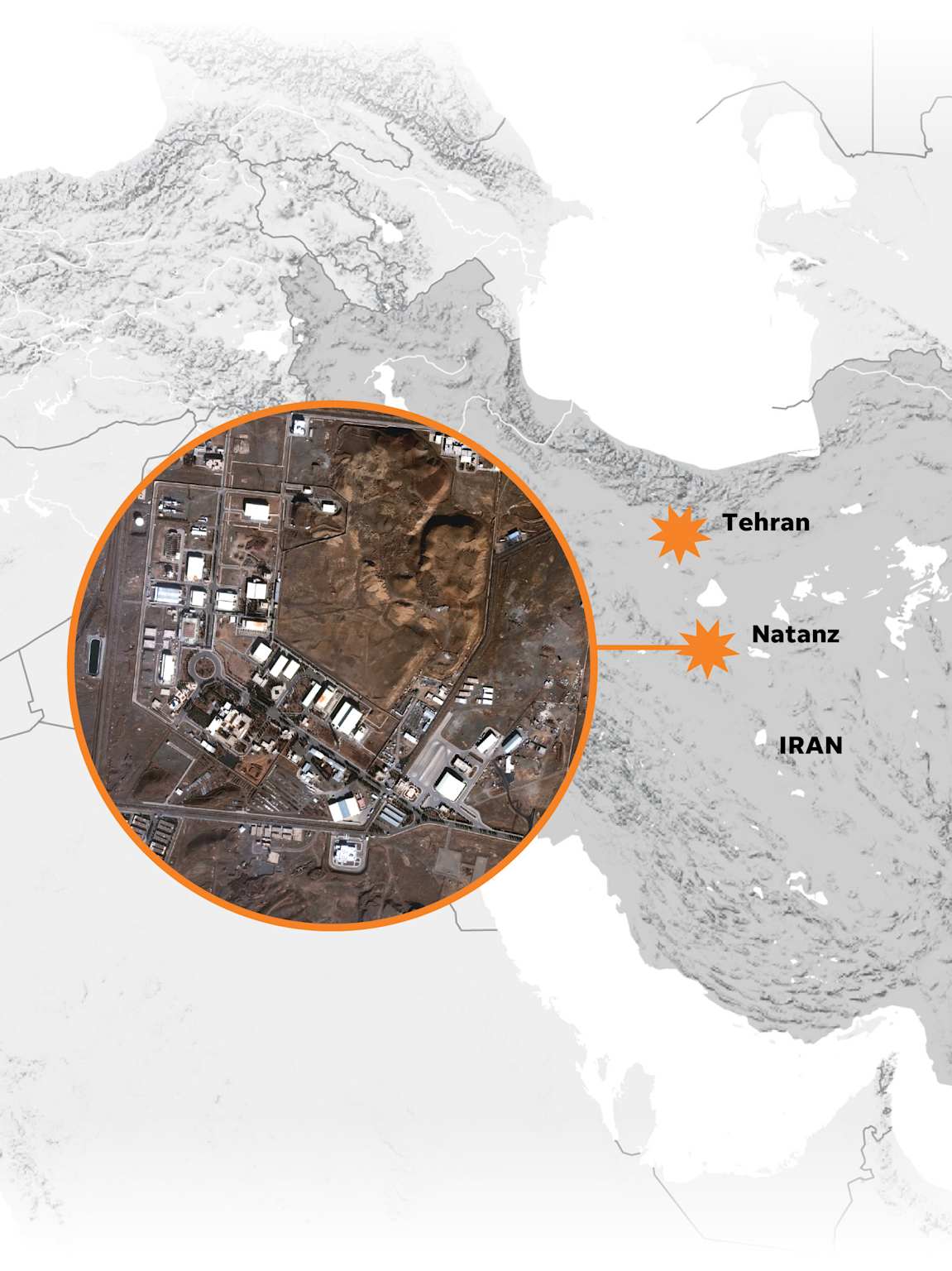
Map of Iran highlighting Tehran and the Natanz nuclear facility.
Conclusion
Nuclear breakout time represents a critical metric in assessing proliferation risks and guiding international responses 13. Through understanding the technical foundations, calculation methodologies, and real-world applications of this concept, we gain insight into one of the most pressing security challenges of our time 35.
The case of Iran illustrates both the utility and limitations of breakout time as an analytical tool 626. While technical assessments provide valuable information, they must be complemented by diplomatic engagement, effective verification, and a comprehensive approach to addressing proliferation concerns 2631.
As technologies advance and geopolitical tensions evolve, maintaining rigorous monitoring systems and fostering international cooperation will remain essential to preventing nuclear proliferation and preserving global security 2731.
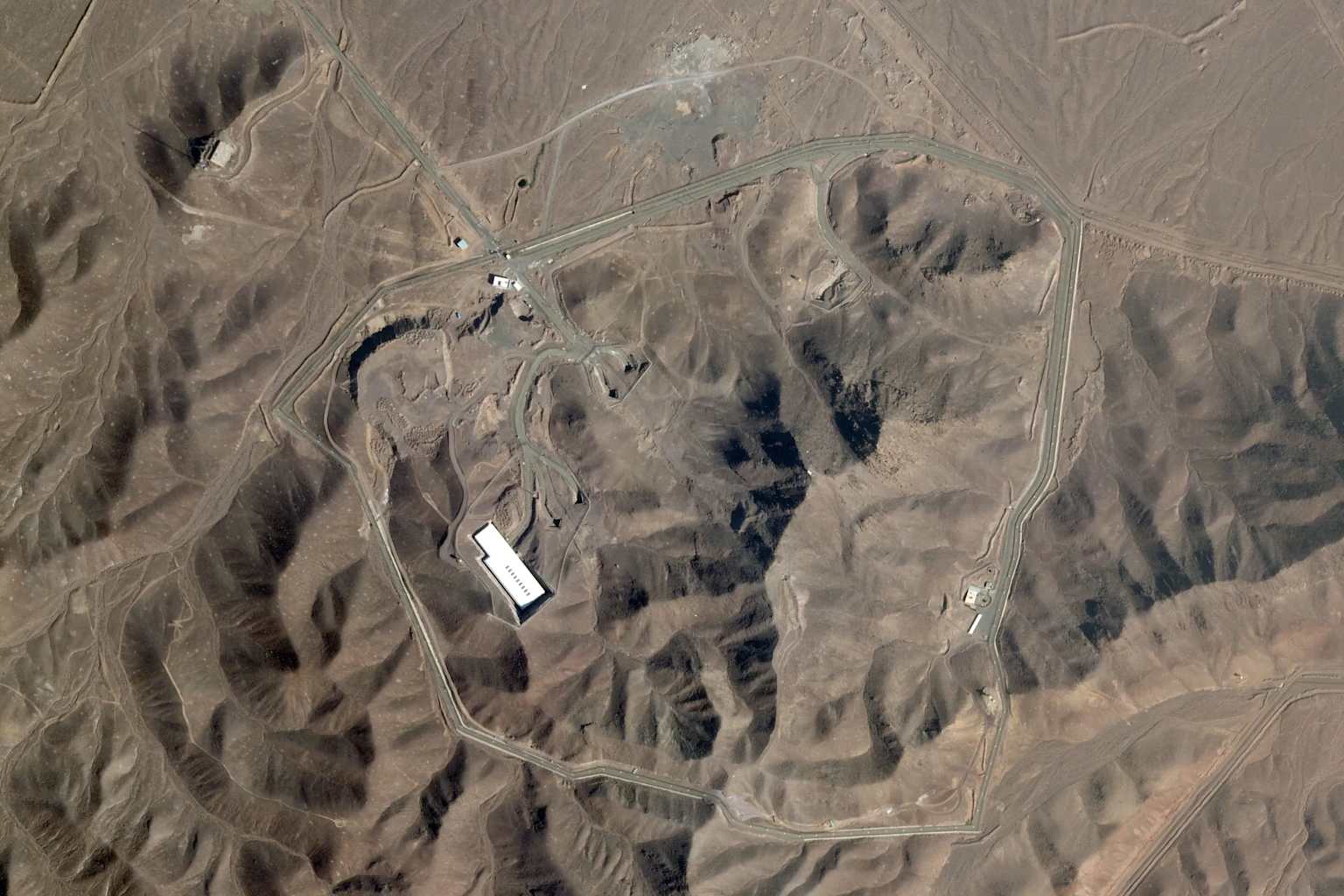
Satellite view of the Fordow nuclear facility in Iran, an underground site critical to discussions on Iran’s nuclear breakout time.
Footnotes
-
https://www.washingtoninstitute.org/policy-analysis/iranian-nuclear-breakout-what-it-and-how-calculate-it ↩ ↩2 ↩3 ↩4
-
https://timesofindia.indiatimes.com/world/middle-east/iran-israel-conflict-bunker-buster-nuclear-breakout-time-key-words-and-phrases-explained/articleshow/121932094.cms ↩ ↩2
-
https://www.washingtoninstitute.org/policy-analysis/irans-nuclear-breakout-time-fact-sheet ↩ ↩2 ↩3 ↩4 ↩5 ↩6 ↩7 ↩8 ↩9 ↩10 ↩11 ↩12 ↩13 ↩14 ↩15 ↩16
-
https://www.cnn.com/2024/07/19/politics/blinken-nuclear-weapon-breakout-time ↩ ↩2 ↩3 ↩4 ↩5 ↩6 ↩7 ↩8 ↩9 ↩10
-
https://www.cnn.com/2024/07/19/world/video/antony-blinken-iran-nuclear-weapon-breakout-time-digvid ↩ ↩2 ↩3 ↩4 ↩5 ↩6 ↩7 ↩8 ↩9 ↩10
-
https://www.armscontrol.org/factsheets/timeline-nuclear-diplomacy-iran-1967-2023 ↩ ↩2 ↩3 ↩4 ↩5
-
https://www.fdd.org/analysis/2024/08/21/iran-is-shockingly-close-to-nuclear-breakout-potential-the-world-must-act/ ↩ ↩2 ↩3 ↩4 ↩5 ↩6
-
https://ec.europa.eu/eurostat/statistics-explained/index.php/Glossary:Separative_work_unit_(SWU) ↩
-
https://energyeducation.ca/encyclopedia/Separative_work_unit ↩ ↩2 ↩3 ↩4 ↩5
-
https://world-nuclear.org/information-library/nuclear-fuel-cycle/conversion-enrichment-and-fabrication/uranium-enrichment ↩
-
https://programs.fas.org/ssp/nukes/nuclear power and fuel cycle/swu calc.html ↩ ↩2 ↩3
-
http://www.acamedia.info/politics/nonproliferation/references/fas-u_enrich_calc.htm ↩ ↩2 ↩3
-
https://tutorials.nti.org/nuclear-101/uranium-enrichment/ ↩ ↩2
-
https://isis-online.org/uploads/conferences/audio-video/separative_work_October_30_2014_-_5-2.pdf ↩ ↩2 ↩3 ↩4 ↩5
-
https://en.wikipedia.org/wiki/Fordow_Fuel_Enrichment_Plant ↩ ↩2 ↩3 ↩4 ↩5 ↩6 ↩7 ↩8 ↩9
-
https://www.csis.org/analysis/options-targeting-irans-fordow-nuclear-facility ↩ ↩2 ↩3 ↩4 ↩5
-
https://www.cnn.com/2025/06/17/middleeast/iran-fordow-nuclear-site-latam-hnk-intl ↩ ↩2 ↩3 ↩4 ↩5
-
https://www.cbsnews.com/news/israel-iran-war-fordo-nuclear-site/ ↩ ↩2
-
https://www.aljazeera.com/news/2025/6/19/what-is-irans-fordow-nuclear-facility-and-could-us-weapons-destroy-it ↩ ↩2 ↩3 ↩4
-
https://iranprimer.usip.org/blog/2025/jan/13/coming-iranian-nuclear-challenge-2025 ↩
-
https://www.csis.org/analysis/three-things-will-determine-irans-nuclear-future-fordow-just-one-them ↩ ↩2 ↩3 ↩4 ↩5 ↩6 ↩7 ↩8
-
https://www.iaea.org/newscenter/focus/iran/iaea-and-iran-iaea-board-reports ↩
-
https://www.iaea.org/sites/default/files/25/06/gov2025-24.pdf ↩ ↩2 ↩3 ↩4 ↩5 ↩6 ↩7 ↩8 ↩9 ↩10
-
https://isis-online.org/isis-reports/detail/analysis-of-the-iaeas-comprehensive-iran-npt-safeguards-report-may-2025 ↩ ↩2 ↩3 ↩4 ↩5 ↩6 ↩7 ↩8 ↩9
-
https://www.iaea.org/sites/default/files/25/06/gov2025-25.pdf ↩ ↩2 ↩3 ↩4 ↩5 ↩6 ↩7
-
https://www.ans.org/news/article-7122/iaea-reports-on-safety-status-of-irans-nuclear-facilities/ ↩ ↩2 ↩3
-
https://abcnews.go.com/Politics/irans-nuclear-program-amid-assessments/story?id=122929192 ↩ ↩2 ↩3
-
https://www.cnn.com/2024/11/19/middleeast/iran-nuclear-enrichment-intl-latam ↩ ↩2 ↩3 ↩4 ↩5
-
https://isis-online.org/isis-reports/detail/analysis-of-iaea-iran-verification-and-monitoring-report-may-2025/ ↩ ↩2 ↩3 ↩4 ↩5
-
https://www.forexfactory.com/thread/1290273-4-hour-timeframe-breakout-method ↩